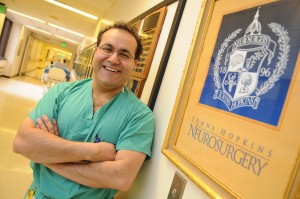Bien Hecho: Dr. Alfredo Quiñones-Hinojosa

![]() By Kayla Gonzalez, LIN@R
By Kayla Gonzalez, LIN@R
He is the immigrant farm-worker who turned neurosurgeon, runs marathons, does research, mentoring, fundraising and keeps his Blog “Q’s Quest” up to date. But Dr. Alfredo Quiñones-Hinojosa still enjoys the simple pleasures of life: wishing his wife and children a good morning while enjoying a large cup of coffee at home.
Dr. Quiñones-Hinojosa spends his days in the operating room, teaching as Professor of Neurosurgery and Oncology, Neuroscience and Cellular and Molecule Medicine at John Hopkins Hospital in Baltimore. In addition to directing the Brain Tumor Surgery Program at Johns Hopkins Bayview Hospital, and the Pituitary Surgery Program at the John Hopkins Hospital, Dr. Quiñones-Hinojosa leads the brain Tumor Stem Cell Laboratory, as detailed on the Hospital website. His life’s work, however, is dedicated to countless hours spent in laboratories in search of a cure for brain cancer; a disease that based on information from the National Brain Tumor Society affects over 600,000 people in the US.
Dr. Quiñones-Hinojosa was nineteen years old when he jumped over a United States border fence from Mexicali, Mexico into the city of Calexico in California. To make a living, he worked in the fields of the San Joaquin Valley where he picked a variety of vegetables.
After a year of farm work, he found work as a welder, painter and driver at California Railcar Repair. It was here where Dr. Quinones-Hinojosa , who was twenty-one at the time, almost lost his life after falling into an oil tanker. Saved by his willpower, his colleagues, and his father, who also worked there at the time, Quinones-Hinojosa awoke in a hospital bed, ready to begin the rest of his life.
In the midst of all of his hard labor, Quinones-Hinojosa began his studies at the San Joaquin Delta College, where he enrolled to learn English. With the help of mentors, he received a scholarship to the University of California, Berkeley, and then Harvard Medical School. He received his citizenship during his time at Harvard, and finished his residency in 2005 at the University of California, San Francisco.
“I’m trying to change this stereotype. We’re not bad people. We want to make this country beautiful.” – Dr. Quinones-Hinojosa
Dr. Alfredo Quiñones-Hinojosa received on September the “Chair’s Award” from the Congressional Hispanic Caucus Institute (CHCI) during the group 35th Anniversary Award Gala in Washington D.C.
“Dr. Alfredo Quiñones-Hinojosa’s story of sacrifice, dedication, and the success of achieving the American Dream through hard work is a testament to the mission of the CHCI and the entire Latino community,” said Chair Gonzalez. “Great leaders lead by setting an example and Dr. Quiñones’ life is an inspiration to us all”. (Quote from the CHCI website)
Becoming a writer
One of Quinoñes-Hinojosa strengths is not only his work-ethic, which led him to become one of the top neurosurgeons in the country, but his passion for his work. In 2011 he published Becoming Dr. Q, a biography that recently received the Latino Book Award 2012 byLatino Literacy Now, a non-profit organization presided by the actor Edward James Olmos . “The Q symbolizes the evolution of our country,” Quinones-Hinojosa says. “We’re demonized, a sentiment that a lot of people in the U.S. have, but I’m trying to change this stereotype. We’re not bad people. We want to make this country beautiful.”
In Becoming Dr. Q, Quinoñes-Hinojosa explains his reasoning behind the title. What does it take to become Dr. Q? Has he gotten there yet? He says, “I don’t understand myself really well sometimes. I don’t know if I’ll ever become who I want to become. What you want today may not be what you want tomorrow. Will I find a cure for brain cancer? I don’t know, but I do know that I’m going to try.”
Quinoñes-Hinojosa is also chief editor of Schmidek and Sweet’s Operative Neurosurgical Techniques, an encyclopedia of neurosurgery. “Once again, I am the captain of that team”, says Quinones-Hinojosa, who recalls how he came into that position. “[Schmidek] invited me to be a part of his trip. I had written a chapter, but unfortunately, he died in 2008. It’s a massive undertake with 212 chapters.”
“I don’t expect my country to give me anything. What I want is to give my country a lot.” – Dr. Quinones-Hinojosa
An immigrant view
With stricter immigration laws and the United States border being harder to cross, Dr. Quinones-Hinojosa remains optimistic and dedicated to this country. In response to immigrant discrimination, he blames it on fear. “We fear what’s going on in our economy,” he says. “It’s not fear that matters, it’s how we deal with that fear. Don’t blame us [immigrants] for the crises in this country.”
Dr. Quiñones-Hinojosa considers the recently-passed Arizona law allowing police officers to stop pedestrians on the street and ask for documentation or proof of citizenship a disgrace to the United States. Nonetheless, his unwavering patriotism allows him to keep in mind the true meaning of the American Dream. “We believe in the systems we have created,” he says. “At the end of the day, we should all believe that this is the most beautiful country.”
Dr. Quiñones-Hinojosa chose a profession that allowed him to fulfill this dream. For him, the American Dream involves working hard, caring for patients, and spending time with his wife, Anna, and three children.
“In life, nothing is for free,” says Dr. Quiñones-Hinojosa. “That’s the price of triumph for everyone who comes to this country. You have to be willing to sacrifice. I don’t expect my country to give me anything. What I want is to give my country a lot.”
For more information about Dr. Quiñones-Hinojosa:
Brain cancer resources:
American Brain Tumor Association
En español:
This article was first published in LIN@R.
Kayla Gonzalez is a staff writer at LIN@R.
[Photo courtesy LIN@R]

